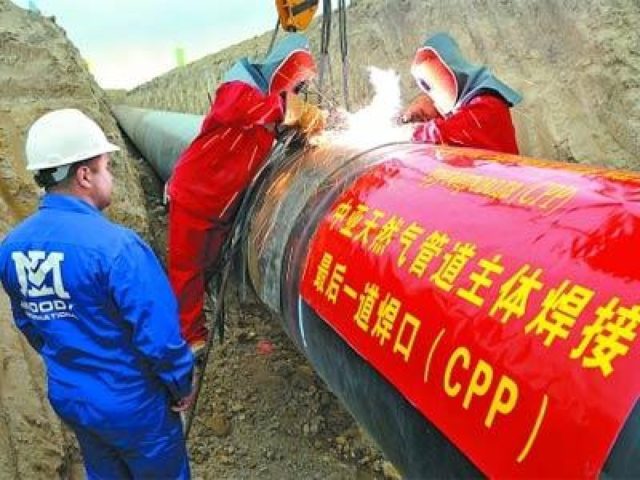
Russia Tightens Its Grip on Uzbekistan’s Oil and Gas Industry
Publication: Eurasia Daily Monitor Volume: 16 Issue: 36
By:

A major challenge for Central Asia’s oil and natural gas industry has always been how to transport petroleum products from the landlocked region to global markets. That issue resurfaced last week (March 6) in Uzbekistan, where a delay in building a pipeline to export more gas to China helped Russia deepen its hold on the domestic energy industry. The Central Asian republic’s liquidity crunch has allowed Russia’s Lukoil to acquire local petroleum assets as well as to boost supplies of Russian gas to Uzbekistani consumers—thereby, putting Moscow in a much stronger position to dictate the terms for gas exports from Uzbekistan.
A comment from Lukoil’s leadership this past week put the pipeline issue in the spotlight. According to the energy company, Uzbekistan owes Lukoil $600 million for gas because local customers have lately been consuming excessive amounts of heating and cooking fuel (Trend, March 6). Uzbekistan consumed 43 bcm of gas in 2017—almost three times Kazakhstan’s consumption. One reason for this is that Uzbekistan’s population of 33 million is 2.5 times larger than Kazakhstan’s 14 million. Another reason relates to the fact that Uzbekistan’s centralized domestic pipeline network is inefficient and its own gas impure, containing lots of toxins (Iea.org, accessed March 14).
Uzbekistan was a gas-export powerhouse until the mid-1990s, when its major fields matured and production plummeted from a peak of 20 billion cubic meters (bcm) a year (Ceicdata.com, accessed March 14). Lacking the capital to develop additional fields, the government privatized the oil and gas industry in the early 2000s.
Most of the natural gas that Uzbekistan currently exports is carried via the 7,000-kilometer, Central Asia–China Pipeline, to China’s northwestern province of Xinjiang. But the three-line pipeline system is expected to reach its maximum capacity of 55 bcm this year, mainly due to increased volumes coming from Kazakhstan (Nikkei Asian Review, October 28, 2018).
China has been dragging its feet since 2014 on helping to finance a promised fourth line to the system. The line would run from Turkmenistan, through Uzbekistan and Tajikistan, to China’s southwestern border. In 2017, Uzbekistan and China announced an indefinite delay on the start of the fourth line’s construction (Trend, March 4, 2017).
Strained personal relations between Uzbekistan’s former president Islam Karimov and other Central Asian heads of state complicated the country’s ties with its neighbors until his death in 2016. The first official visit of Karimov’s successor, Shavkat Mirziyoyev, was to Turkmenistan, which has Central Asia’s largest gas reserves. One of Mirziryaev’s hopes was that Turkmenistan would help put the Central Asia–China pipeline project back on track (Radio Free Europe, April 27, 2018). Although the visit was heralded as signifying a new era in Uzbekistani-Turkmenistani relations—and Turkmenistan’s President Gurbanguly Berdimuhammedov reciprocated that notion—expansion of the pipeline remains on hold. Mirziyoyev even tried to sweeten the pie, suggesting that Uzbekistan would join the Turkmenistan–Afghanistan–Pakistan–India (TAPI) pipeline project that would deliver Turkmenistani gas to Pakistan’s and India’s huge markets gas (Tashkent Times, April 24, 2018), but so far to no avail.
Alexei Miller, the CEO of Russia’s state-owned energy giant Gazprom, announced in 2018 that the company would begin importing Turkmenistani gas again as of January 1, 2019, after settling a bilateral pricing dispute that had cut off supplies in 2016 (Nikkei Asian Review, November 20, 2018). Before the cut-off, Gazprom re-exported 10–12 bcm a year of cheaper Turkmenistani gas through Ukraine to Europe (Oilprice.com, July 28, 2015). In addition to maintaining its position as Europe’s largest supplier, Gazprom has substantially increased its supplies to China in recent years.
It is unclear whether Gazprom has begun re-importing Turkmenistani gas to date (Azer News, February 11, 2019). But indications that it may have include reports that Turkmenistan has redirected some of its exports from Azerbaijan to Russia (see EDM, February 25).
An intriguing question is what Gazprom will do with the Turkmenistani gas once Russia’s transit contract with Ukraine ends in 2019. Relations between Moscow and Kyiv have been strained since Russia seized Crimea and began supporting the separatists in eastern Ukraine. As a result, whether a new transit contract will surface remains to be seen. One option would be to send Turkmenistani gas to Russia’s Volga-Ural region and export more West Siberian gas to Europe and China. To pull this off, Gazprom would need a cost-effective price for the imported gas.
What do these developments mean for Uzbekistan? First, both the delay in the construction of the pipeline to China and the resumption of Turkmenistan’s supplies to Russia will make it harder for Uzbekistan to secure a suitably high price for the gas it exports through Gazprom. The redirection of a large portion of Turkmenistan’s gas to Russia will also mean less urgency to build the fourth line of the west–east pipeline to China. Moreover, less gas revenue will make it harder for President Mirziyoyev to implement the next phase of his 2017–2021 strategic development program. It will also complicate Uzbekistan’s plans to open its gas industry to Western companies. Finally, the debt to Lukoil could foster this Russian energy company’s dominance in Uzbekistan’s petroleum sector. In lieu of payment, Lukoil could demand more Uzbekistani petroleum assets, as Gazprom did in Armenia (Neftegaz.ru February 8, 2019).
Uzbekistan needs all the revenue it can secure in order to continue growing its economy. This means finding another outlet to export its gas as well as reducing its domestic consumption. Otherwise, Uzbekistan will have to rely on Russia to both supply it with gas for domestic consumption and to export much of the gas it produces to sell abroad.



